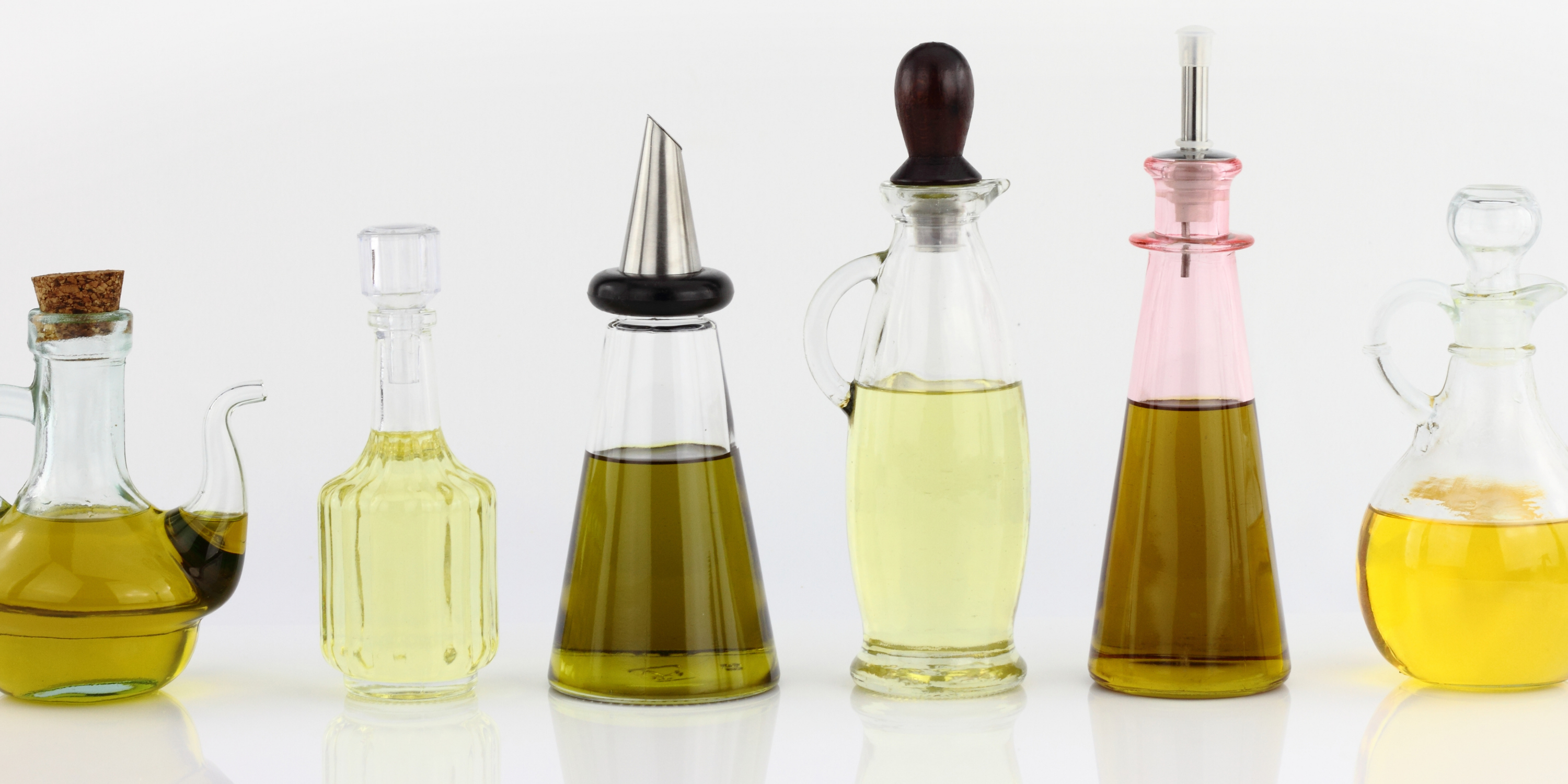Cooking Oils
Which ones should I be using?
Cooking oil choice is extensive nowadays, so how are you supposed to know which one is best? Is there even such a thing? This article breaks down some of the key facts to help you in making your choice.
Why are so many oils available?
The availability of cooking oil has grown considerably over recent years. This is in response to consumers becoming more aware of their perceived health benefits, as well as sustainability and quality concerns, the proliferation of cooking programmes and with our desire to consume more foods from around the world.
Which oil we choose is largely dependent on the required purpose. This is because all oils contain different characteristics and therefore meet different needs. The key factors we should consider are:
• Food application (e.g. frying, baking, salad dressing)
• Flavour
• Cost
• Environmental impact
• Personal preference
Are cooking oils healthy?
Vegetable oils are a good source of essential fatty acids; contain a small amount of Vitamin E; and are the main source of natural plant sterols in the diet.
Oils comprised of unsaturated fat (e.g. olive) tend to be a healthier choice than oils comprised of saturated fat (e.g. palm).
Regardless of their health status, however, oils are almost entirely fat and therefore contain the same amount of calories as any other fat or oil (9kcal per gram). It is important to consider quantities consumed, and it is advisable to use non-stick pans, blot any excess oil, and grill or bake rather than deep fry.


Are there any oils which are not good for us?
In moderation, there are no oils which are ‘bad’ for us, however, high intakes of saturated fats and trans fats can have damaging effects. This is because the body’s ‘bad cholesterol’ is increased, and ‘good cholesterol’ is decreased (the kind that helps unclog arteries).
How are oils produced?
Vegetable oils are obtained from plants and plant materials including seeds, beans, nuts, and fruits. To achieve a product that is uniform in taste, smell, appearance, texture and has a decent shelf life, most commercial processors undergo numerous steps. These include:
• Extracting the oil
• Refining it to remove unwanted residues/particles
• Modifying it to get the desired functional properties
• Evaporating less stable compounds which might cause ‘unusual’ odours or flavours
• Adding preservatives to counteract the high-temperature processing
Some cooking oils are unrefined (e.g. extra virgin olive oil), meaning they haven’t been exposed to high temperatures and chemical processing, which could offer more nutritional benefits


What cooking oil should I use?
It’s helpful to consider an oil’s ‘smoke point’ – the temperature at which an oil starts to burn/smoke – when choosing a cooking oil. Otherwise, you may end up with a dish that tastes burnt or bitter if you go beyond this point.
Previously, the smoke point was also considered to be the most important factor for the safety of cooking oils at high temperatures. It was assumed that the lower an oil’s smoke point, the lower the temperature it should be heated to (to avoid the production of harmful byproducts). However, recent research has suggested that we should instead be focussing on an oil’s ‘oxidative stability’ – its ability to withstand oxidation at high temperatures – when we’re considering safety, which can be different from its smoke point (1).
The absorption of fat is also an important factor, as this significantly affects the nutritional content of the food. This can be heavily influenced by the coating on foods, as breadcrumbs, batter or flour will readily soak up fat. Also, if the temperature is too low, the cooking time is extended, allowing more time for the fat to seep into the food.
For general cooking, use rapeseed or olive oil, and use others for when you want specific flavours.
Oil Types
Each oil contains a range of different fatty acids (saturated and unsaturated), however, one type tends to predominate. In general, the main fatty acid the oil contains is how it is broadly categorised.
1. Monounsaturates
Monounsaturates are a major component of the Mediterranean diet, which has been shown to be beneficial for heart health and cholesterol levels.
Oils in this category are liquid at room temperature and generally more stable than polyunsaturated.
Olive oil
There is little processing/heating involved so the flavour is enhanced and more of the naturally occurring micronutrients are retained. Extra virgin olive oil has the highest monounsaturated fat content of all the oils.
You might have heard that we shouldn’t cook with extra virgin olive oil – but recent research has suggested otherwise! Due to extra virgin olive oil’s low smoke point, it was previously believed that it wasn’t suitable for cooking at high temperatures. However, a recent study comparing the safety of cooking oils suggested that extra-virgin olive oil is safe to heat at high temperatures. In fact, it turns out that extra-virgin olive oil was more chemically stable at high temperatures than other common cooking oils (1).
Rapeseed oil
Most of the generic ‘vegetable oil’ in UK supermarkets is rapeseed oil. It has a neutral flavour, is inexpensive, and is good for lots of different types of cooking.
Peanut oil
This oil can be heated to high temperatures without oxidative effects (so good for deep frying, as well as general frying and cooking). It generally requires limited refining and is particularly popular in Chinese recipes due to its flavourful nutty taste and smell. There is not enough evidence to show peanut oil has the same benefits as peanuts when it comes to reducing risk of cardiovascular disease.
Avocado Oil
This has a very high smoke point and oxidative stability so is suitable for all forms of cooking and cold foods, however, tends to be expensive and is not sustainable.
2. Polyunsaturates
These are liquid at room temperature, but not as stable as other fats as they oxidise easily.
Soybean oil
This is the most widely used oil in the world and has been associated with numerous health benefits (mainly due to it’s phytoestrogen content), however soy is a significant agricultural driver of deforestation worldwide.
Sunflower oil
This has a high smoke point, is high in vitamin E, and great for shallow frying. However, research does suggest that it has a lower oxidative stability compared to olive oil and avocado oil. If you see “high-oleic” on the label this means that the oil has been modified so it is richer in monounsaturated fat than traditional versions would be.
Flaxseed oil
The oil extracted from flaxseed is often called linseed oil. It is not commonly used as a household oil (other than for dressings), but often used in fat spreads and poultry feedings to produce eggs and meat higher in omega-3 fatty acids.
3. Saturates
These are solid at room temperature, and are stable so resist oxidation.
Palm oil
A versatile oil with varied functional and nutritional properties. It can be used at high temperatures, has a prolonged shelf life, and is an economical choice. However, its production has significant negative impact on forest destruction.
Coconut oil
There has been a lot of hype around coconut oil, however no robust scientific literature to verify the claims. Because of its high saturates content it is recommended that coconut oil and products containing it should be consumed in moderation only. It might not be a ‘superfood’, but it is great for flavour, especially in Thai recipes.
Allergens
Refined oils are unlikely to be a problem for people with food allergies, such as peanuts, because the proteins which have the potential to cause allergic reactions are likely to be removed during the manufacturing process.
However, cold-pressed or unrefined/unprocessed (crude) oils are likely to contain the proteins which can cause a reaction in people who are sensitive, so these should be avoided.
When eating out, it is important for allergy sufferers to enquire about the oil used to avoid risks of cross contamination with products containing allergens.
Oil Storage and Disposal
All oils are sensitive to heat, light and exposure to oxygen, so it is important they are stored correctly to prevent them from going ‘rancid’ and off-flavours developing. Ideally, they should be kept in a dark, cool, dry place.
The cap should be replaced tightly on the container after use. Typically, oils should be consumed within 12 months of purchase, but this is usually a matter of personal preference rather than a ‘must use by’. If oil smells bad it should be discarded.
The proper way to dispose of oil is to place it in a sealed non-recyclable container and put with regular refuse. Placing the container of oil in a refrigerator to harden can make disposal less messy.

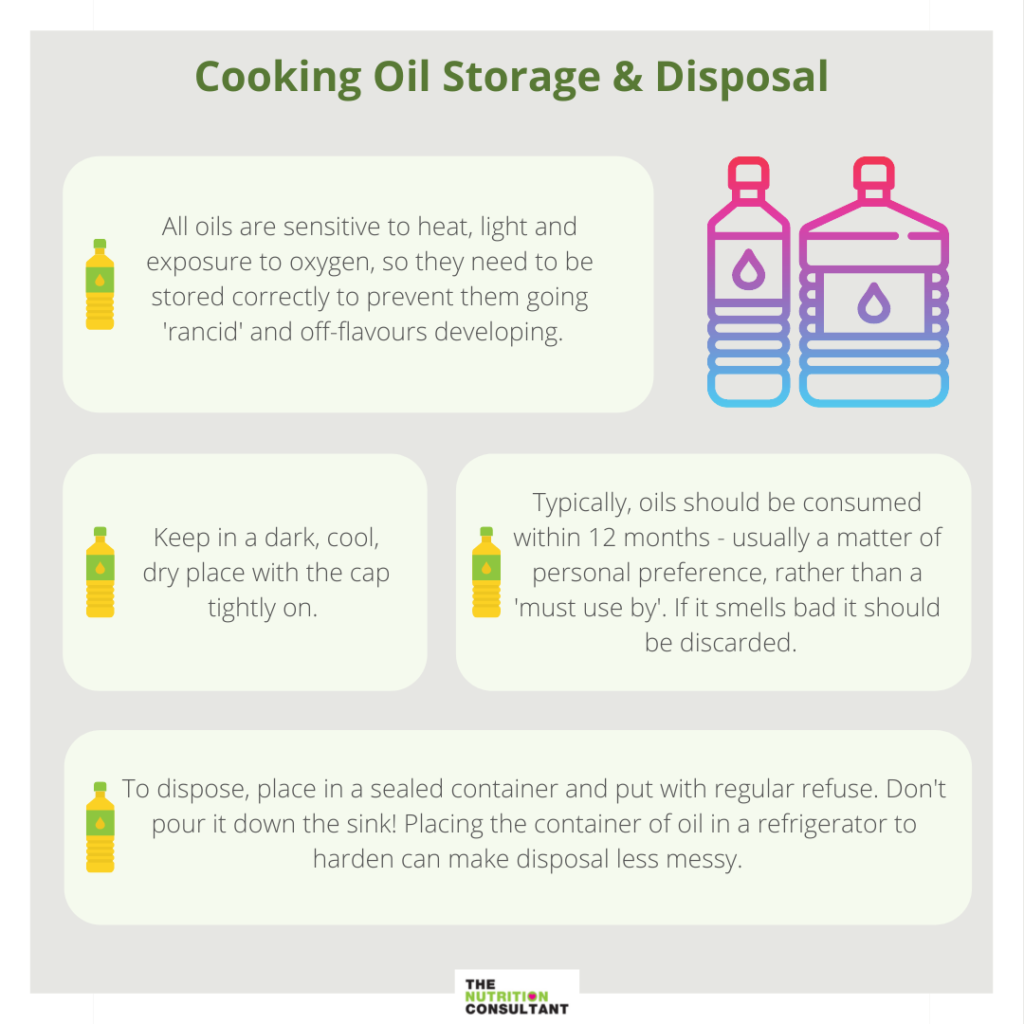
Summary
The oil you choose depends mainly on the food application and personal preference, so there isn’t one particular type which can be deemed to be “the best”. However, as a general rule, unsaturated vegetable oils (particularly monounsaturated) are a good choice.
Whichever oil you use, don’t forget that they are all energy-dense and therefore it is important that quantities are considered. Everything in moderation!

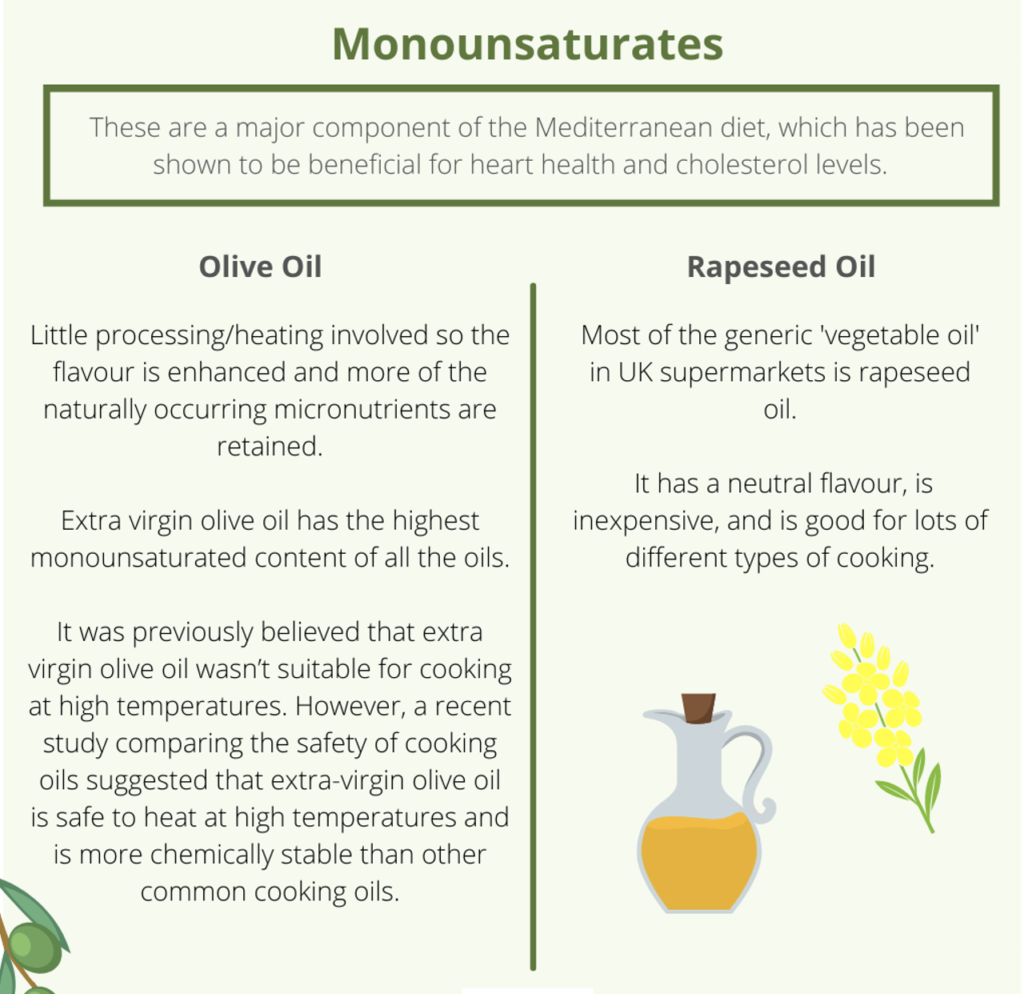
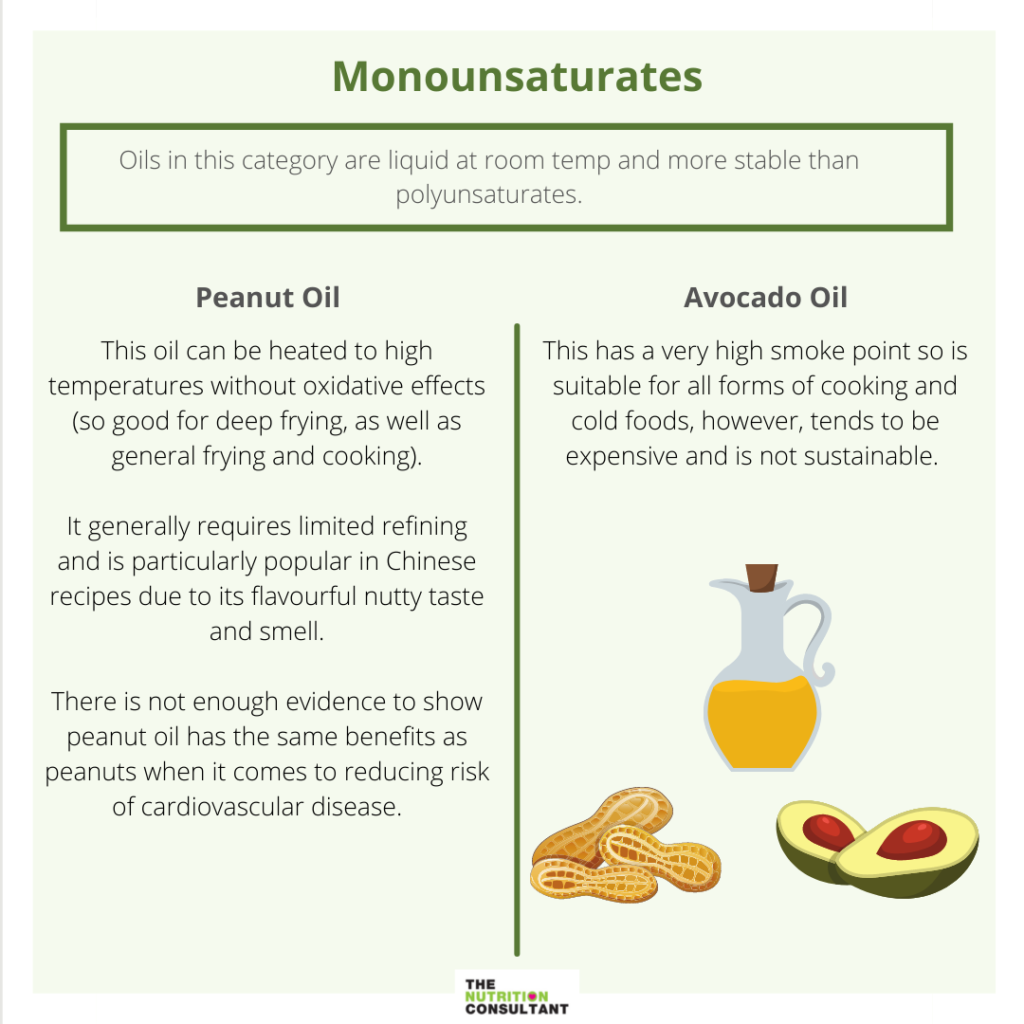


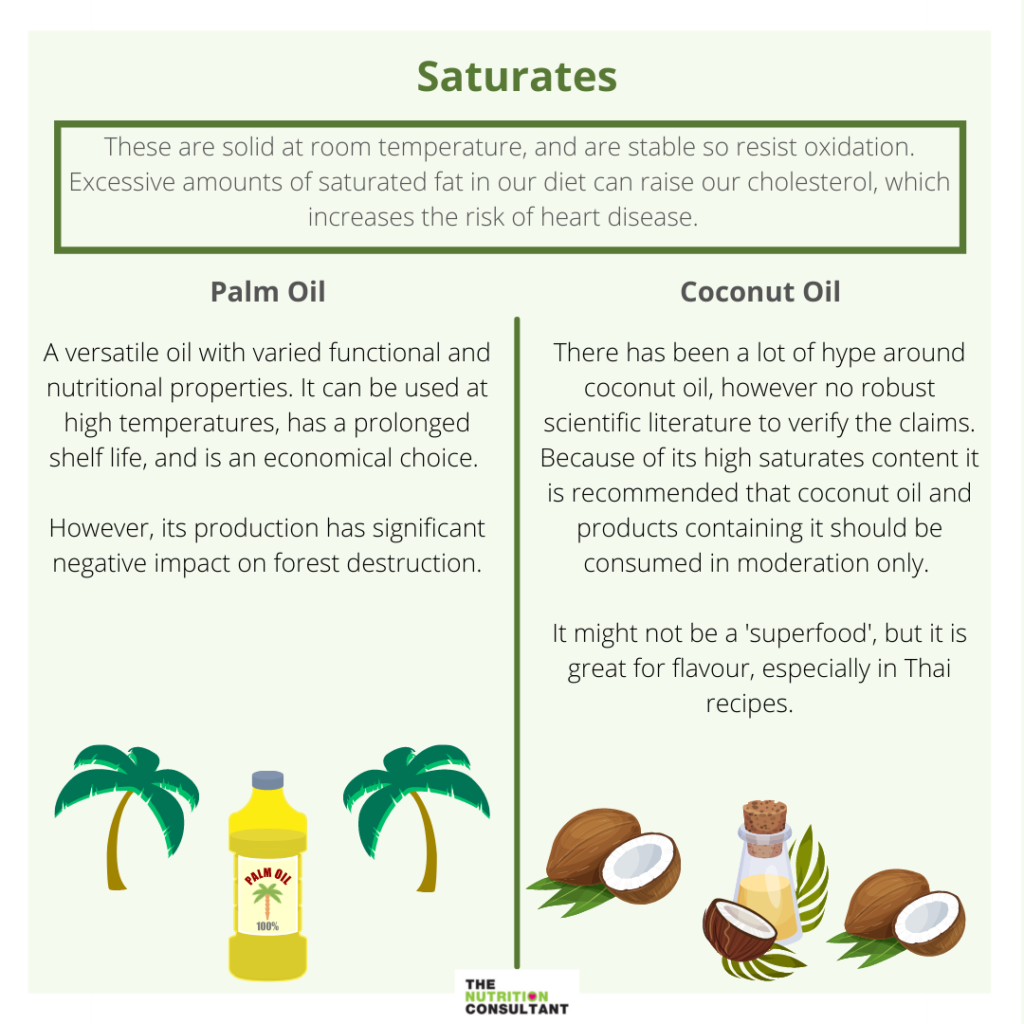
References
Guillaume, C., De Alzaa, F. and Ravetti, L. (2018). Evaluation of chemical and physical changes in different commercial oils during heating. Acta Scientific Nutritional Health, 2(6), pp.2-11.
https://www.bda.uk.com/resource/fat.html
https://www.sciencedirect.com/topics/agricultural-and-biological-sciences/sunflower-oil
https://www.nhs.uk/live-well/eat-well/different-fats-nutrition/
https://www.bda.uk.com/resource/heart-health.html
https://www.anaphylaxis.org.uk/information-training/our-factsheets/
https://www.heart.org/en/healthy-living/healthy-eating/eat-smart/fats/healthy-cooking-oils
https://www.worldwildlife.org/industries/soy
https://guide.michelin.com/us/en/article/features/oil-smoke-point-cooking-quality-safety



